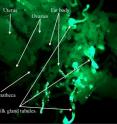Lactating tsetse flies models for lactating mammals?
An unprecedented study of intra-uterine lactation in the tsetse fly, just published in Biology of Reproduction's "Papers-in-Press," reveals that an enzyme found in the fly's milk functions similarly in mammals, making the tsetse a potential model for lipid metabolism during mammalian lactation. Better yet, reduced levels of this enzyme led to poor health in offspring, leading the authors to suggest that targeting it could help decrease the tsetse population in Africa and so reduce the incidence of sleeping sickness. Tsetse flies are bloodsucking flies that inhabit much of subsaharan Africa. They are similar in size to a horsefly and breed along rivers and streams. A pathogenic species of parasite in the genus Trypanosoma can be taken in by the fly while taking a blood meal from an infected human or animal. Flies carrying the parasite can then transmit it to other humans or animals. The disease caused by the trypanosomes is known as sleeping sickness in humans and nagana in wild and domestic animals, including pigs, cattle, and horses.
Sleeping sickness affects about 37 countries and 60 million people, and an estimated 50,000 to 70,000 individuals are infected. Efforts to combat the disease are varied. One effective technique involves sterilizing male tsetse flies and then releasing them to compete with the wild males for breeding rights. The authors of this study suggest that manipulating production of the SMase enzyme and other essential milk proteins in female flies could also aid population reduction efforts.
This is the first study to uncover the biochemical mechanisms of lactation in tsetse flies. Yale University's Joshua B. Benoit and colleagues, with the help of researchers from the Slovak Academy of Sciences, documented that a sphingomyelinase (SMase) enzyme is present in tsetse milk during lactation.
This enzyme is essential for the production of a key component of cell membranes and it functions similarly during mammalian lactation.
Unlike most flies, the female tsetse produces a single egg and ovulates the egg into a uterus. When the larva hatches, it remains in the uterus until it has completed larval development. While the larva is in the uterus, the female fly expresses SMase as a component of the milk secretion of the fly's milk glands. The larva feeds on the milk, and acidic conditions in the larval gut activate the enzyme. When the researchers reduced SMase levels in the lactating mother, the offspring's development and health were impaired.
In humans, defects in SMase-encoding genes causes Niemann-Pick Disease, a neurodegenerative disorder that, in severe cases, causes death before three years of age. Although the mammalian and insect SMases differ, the basic structure and function of the enzymes and their products are similar. Thus, insects could serve as model systems for studying metabolic diseases related to SMase deficiency.
Source: Society for the Study of Reproduction
Other sources
- Lactating tsetse flies models for lactating mammals?from Science DailyWed, 18 Apr 2012, 21:30:42 UTC
- Lactating tsetse flies models for lactating mammals?from PhysorgWed, 18 Apr 2012, 19:00:24 UTC
